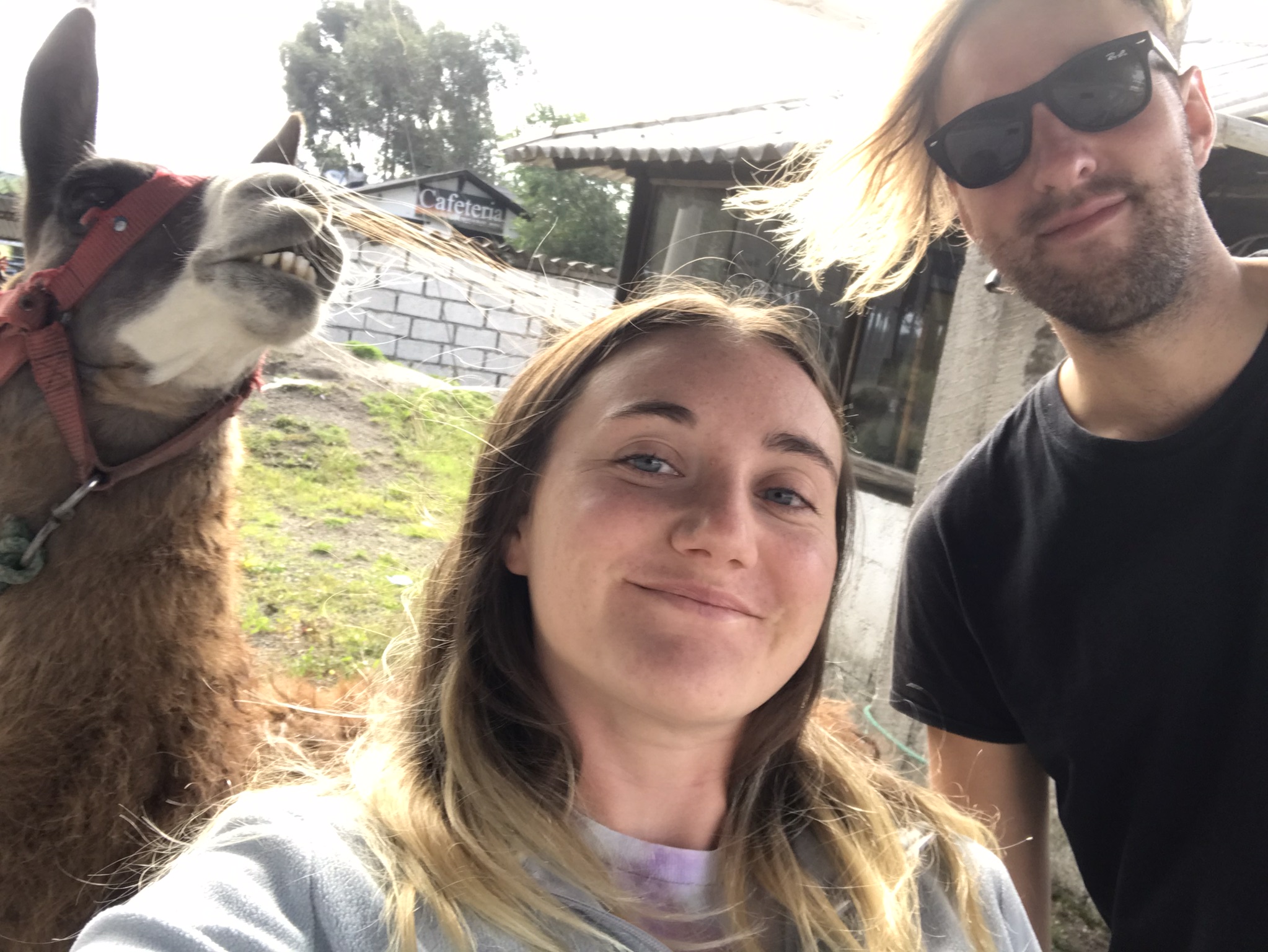Think of the Maldives and the image that comes to mind is likely to be one of eye-wateringly expensive luxury holiday resorts on paradise islands, surrounded with pristine ocean and private beaches. However this isn’t all there is to the Maldives. In fact, the Maldives is a nation with unique geography, a very conservative Muslim culture and a history stretching back thousands of years. More importantly, since the recent opening of ‘local islands’ to foreign visitors it is possible to visit the Maldives and still experience the essence of the country on a backpacker budget. In fact, for travelers who prefer to immerse themselves in local culture rather than being shut away in a resort, it is probably more fun to do it this way. We visited the Maldives as a transit en route to India and were able to comfortably spend a few days relaxing and exploring on a strict backpacker budget. Check out our Maldives budget travel experiences and tips below!
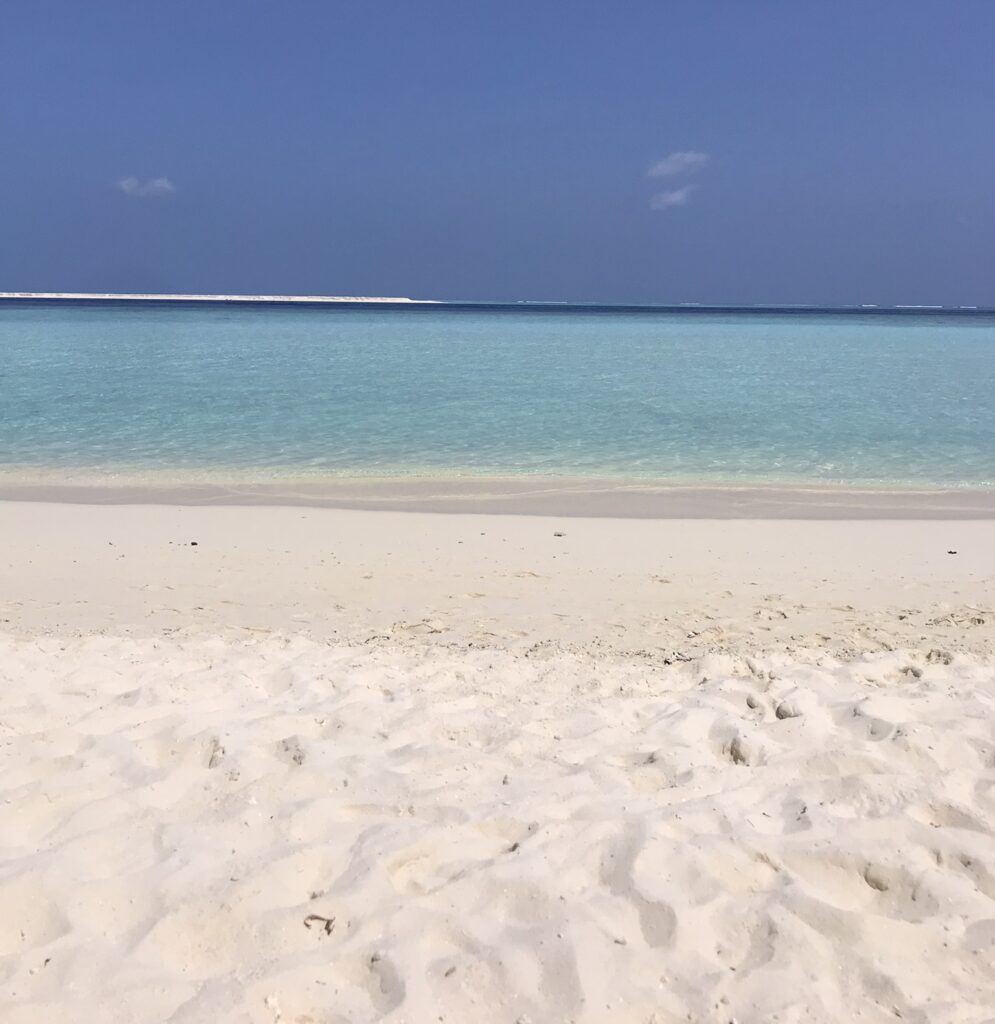
The first thing to note about the Maldives is its unique geography. The Maldives is a collection of 26 atolls (coral islands surrounding lagoons) in the Indian Ocean, covering a geographically large area to the south-west of both India and Sri Lanka. These atolls are partially submerged, creating an array of over a thousand tiny, remote islands, of which a few hundred are populated. Because it is comprised of such small islands, the Maldives is the smallest country in Asia by land mass, one of the most spatially dispersed and also one of the most densely populated countries in the world. Nowhere is this more visible than chaotic Malé, the capital which is home to around 40% of the country’s population and is one of the most densely populated cities in the world. Every inch of land on the Maldives is valuable, and the lack of space means that the nation struggles with things like waste disposal and agriculture. Around Malé you can see specific islands which are dedicated to sanitation and waste management. The Maldives is also the lowest country in the world and is extremely susceptible to climate change.
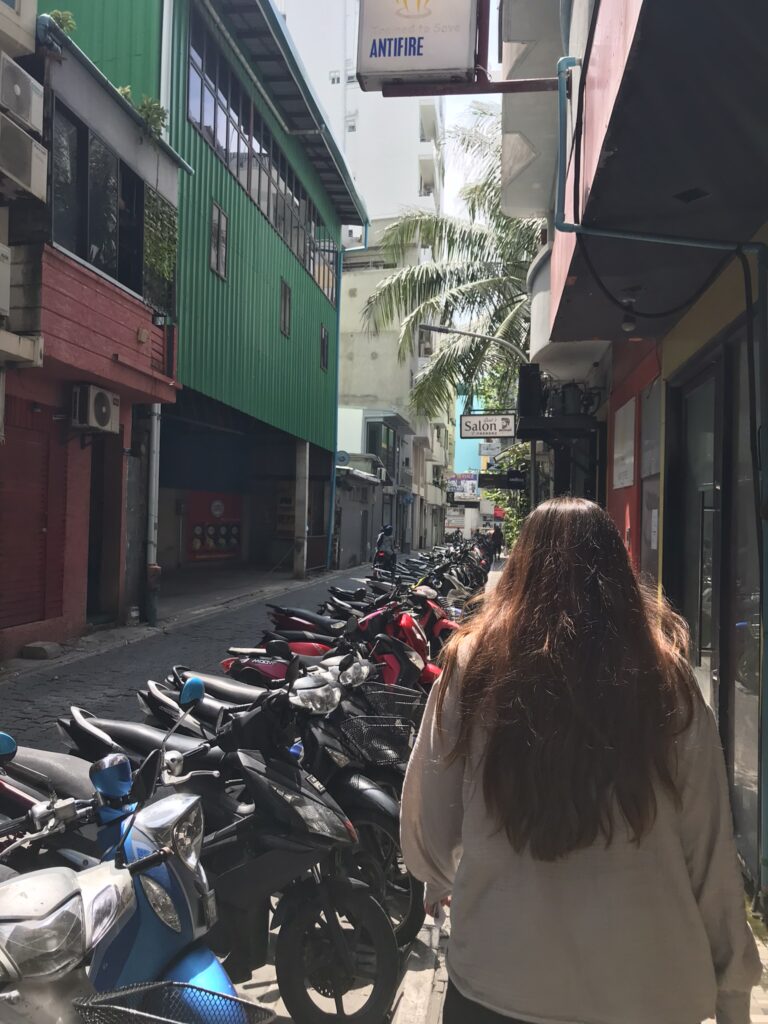
A typical street lined with mopeds in Malé
Culturally, the Maldives is also quite a unique place with its own currency, language, script, cuisine and history stretching back thousands of years. The Maldives was formerly a Buddhist kingdom and later became an Islamic sultanate, and was then absorbed into the British Raj before peacefully gaining its independence from Britain in 1965. Today it is a presidential democracy. Sadly, despite its history there are very few archaeological sites that can be easily visited on the Maldives – visiting the country is really just all about the sun and sea.
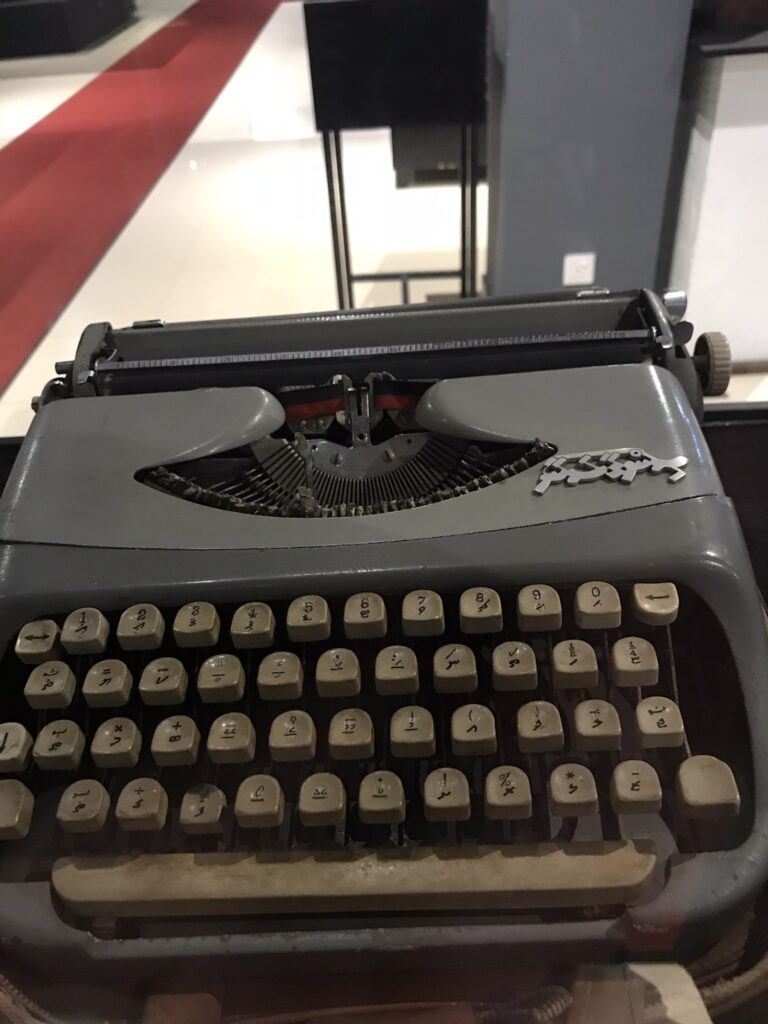
The first ever typewriter in the Thaana script is on display in the National Museum
Despite its reputation as a luxury holiday destination, outside of the resorts the Maldives is actually a very conservative Muslim country which operates under Sharia law. Although it has year-round heat and humidity, walking around in swimwear, shorts or sleeveless tops is strictly forbidden for both males and females. We saw many women wearing niqabs and full burkas in Malé. Most islands have specially designated beaches where swimwear is permitted, dubbed ‘bikini beaches’; outside of this, any swimming needs to be done fully clothed. We saw quite a few locals submerging themselves fully-clothed on the artificial beach in Malé, which was quite an odd sight given the paradise island surroundings. Outside of the resorts, pork products and alcohol are strictly prohibited and you can even get in trouble for bringing a Bible or other non-Islamic religious texts into the country!
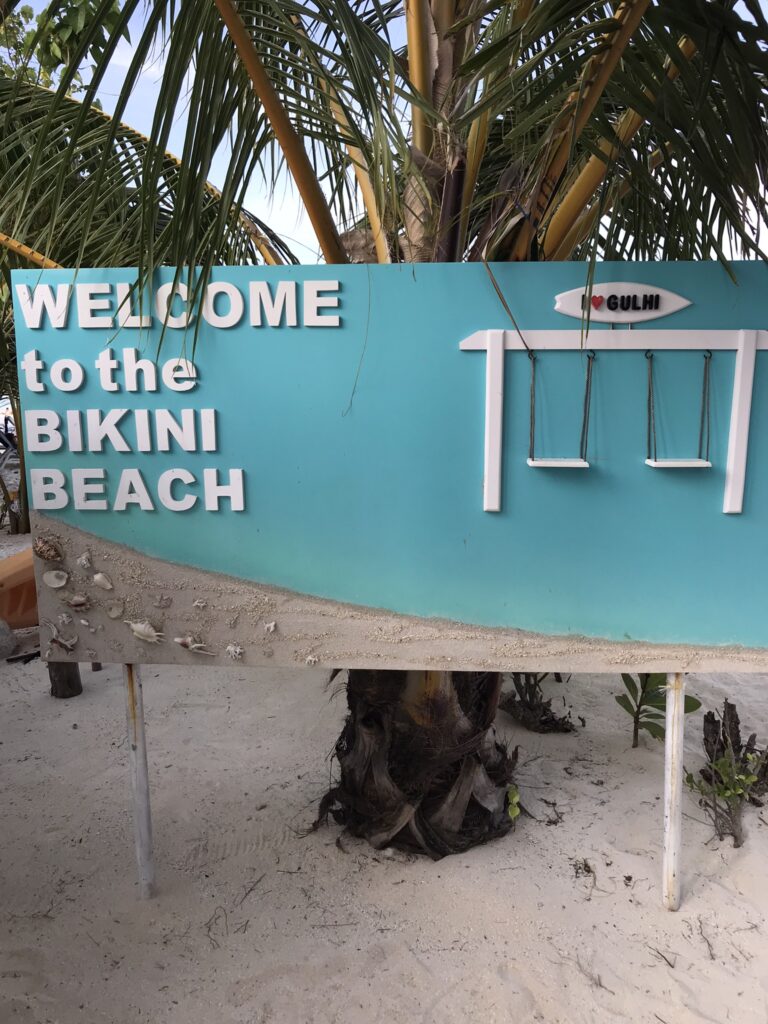
The bikini beach is the only place that swimwear is allowed
Outside of the Malé, the Maldives’ many islands are broadly split into two categories: private islands and ‘local islands’. The private islands are typically owned by either wealthy private individuals or, more commonly, international hotel chains or investors. These islands are the ones you have probably pictured when thinking of the Maldives, containing 5* luxury resorts with their wooden cabanas, swimming pools and beaches. While of course they are still part of the Maldives, the private hotel islands don’t operate to the same strict restrictions and religious customs as the rest of the country. Alcohol is allowed, bikinis are welcomed and the resorts contain all the amenities to cater to international holidaymakers and justify their high price tags.
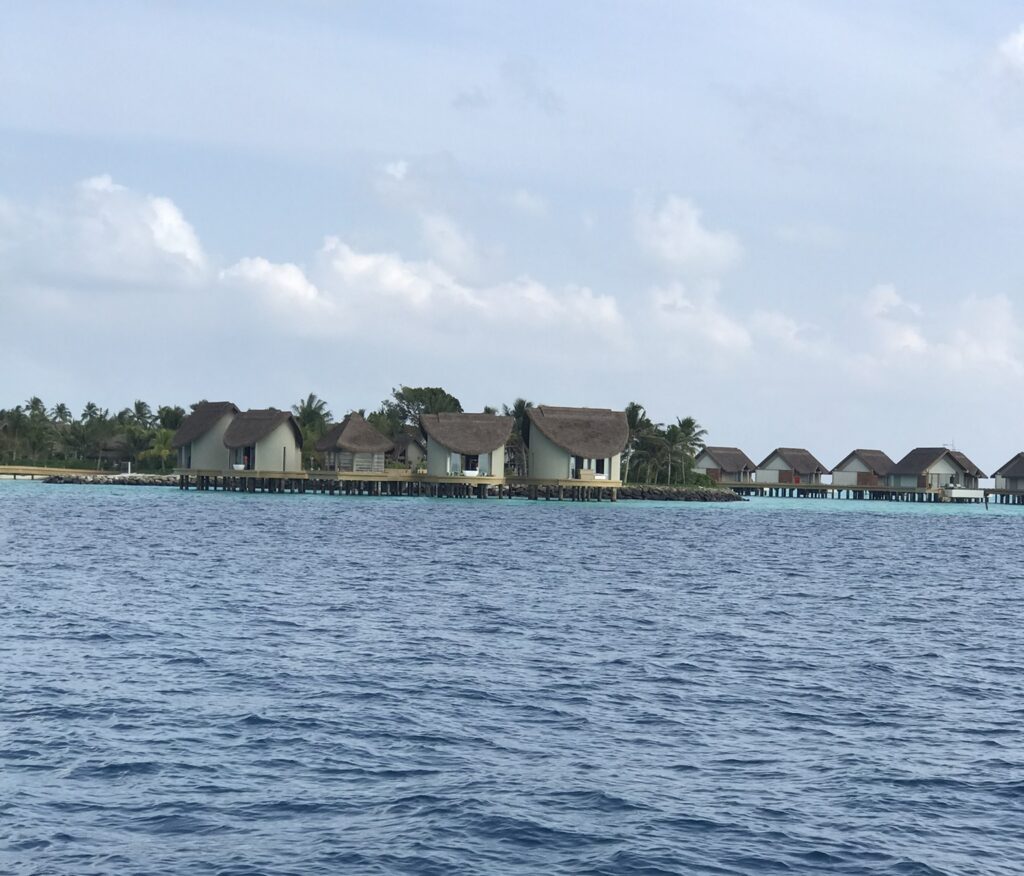
A sneak peak of a resort island from the dhoni ferry
The ‘local islands’ are a different story. These islands are the bread-and-butter of the Maldives, containing small villages or towns where the majority of the local Maldivian people live. Prior to 2009, these local islands were off-limits to foreigners meaning the expensive resorts were the only option for visitors to the country. However, since regulations changed, the local islands are now flourishing with homestays, guesthouses and budget hotels catering for tourists who are looking for a more authentic and less pricey Maldives experience. The local islands are under Sharia Law and are subject to the same strict restrictions as Malé, so don’t expect alcohol or a resort atmosphere. Outside of the bikini beach, it is still forbidden to walk around in swimwear on these islands.
We had a few days in the Maldives while transiting to India and chose to spend our time in both Malé and on a nearby local island, Gulhi. There are many, many local islands with guesthouses to choose from, in the end we chose Gulhi because it wasn’t too far away from Malé and contained affordable and highly-rated accommodation. I can’t comment on the merits of Gulhi vs any other local islands, but I felt like it was probably fairly typical and we enjoyed our experience. We would’ve liked to visit more of the local islands if we had more time in the country.
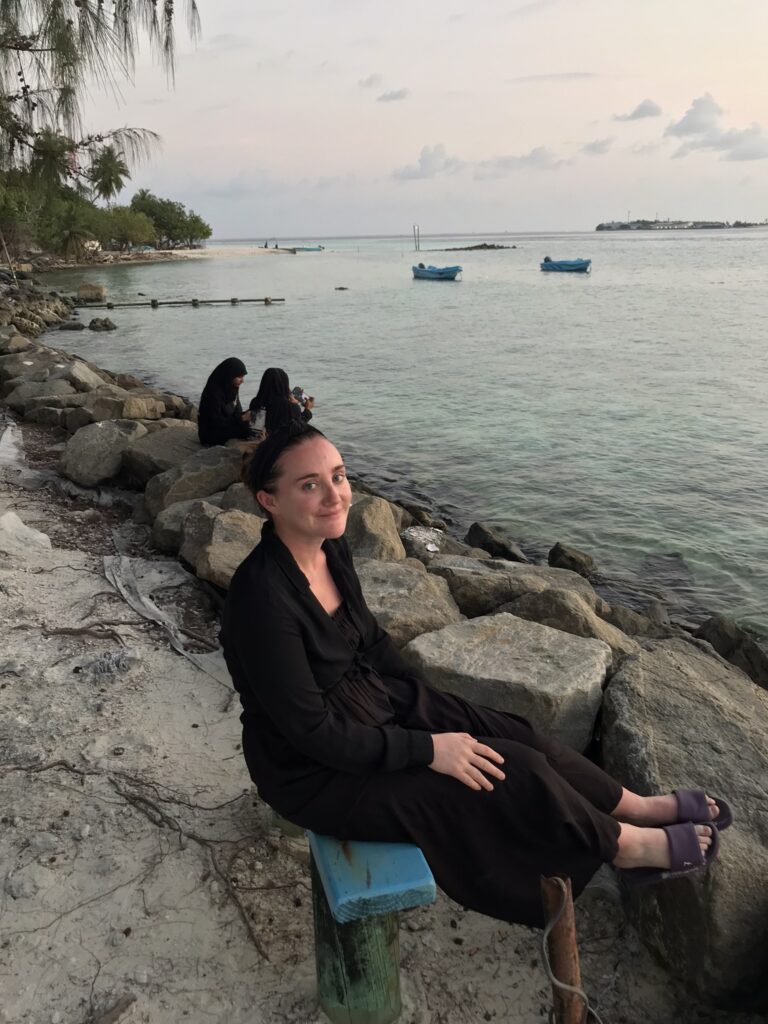
On the shores of Gulhi, a local island
When arriving in the Maldives, you are likely to land at the airport in Hulhule (adjacent to Malé) – from there you can easily take the ferry to Malé, and the entire city is then compact enough that it is walkable. If you choose (and can afford) to stay in one of the expensive private resort islands, a speedboat transfer from the airport is usually included. However, if you’re traveling like us and want to visit one or more of the local islands, you will need to make your own way and probably spend a few nights in Malé too. When visiting the local islands, there are two options – speedboats, which run regularly but are far more expensive, or the local ‘dhoni’ slow ferries, which ply along predetermined routes. Rough ferry routes and schedules can be found here (ignore the rest of the info on that page), but it is probably best to go to the dock the day before to find the most accurate and up-to-date info. Dhoni ferries often don’t run on Fridays (the Islamic holy day), so prepare accordingly!
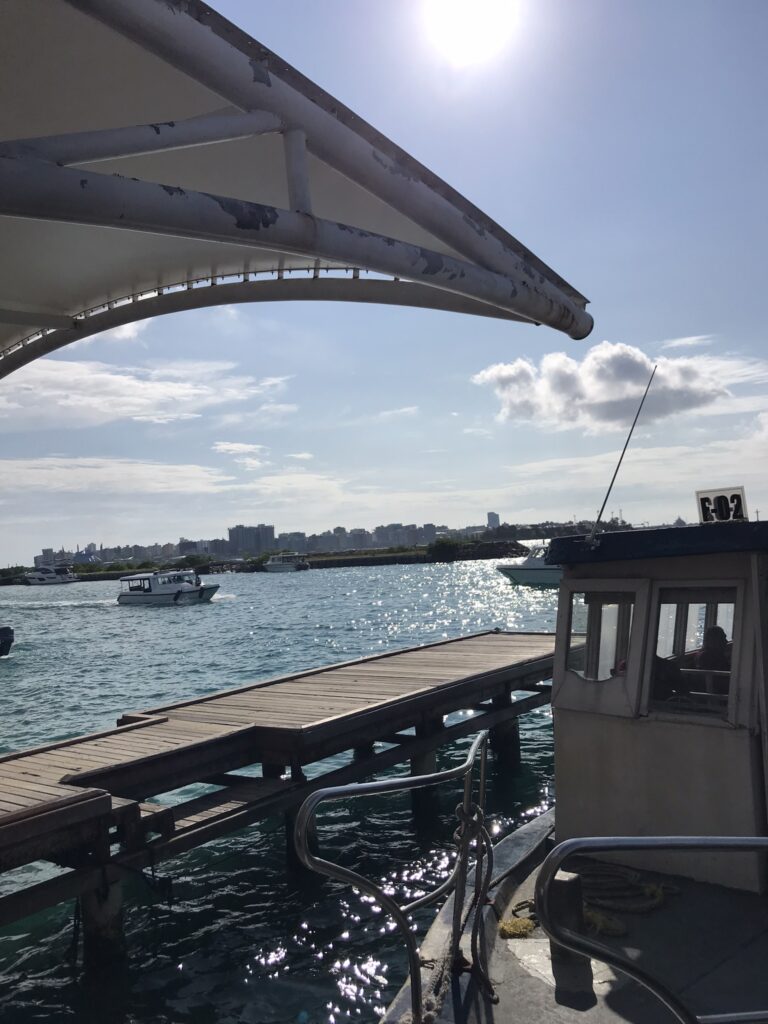
Just steps outside the main airport entrance is the ferry port to Malé

Taking the local ferry is a great way to save money!
For my blog post on local transport, money-saving and other Maldives travel tips, click here!
Malé
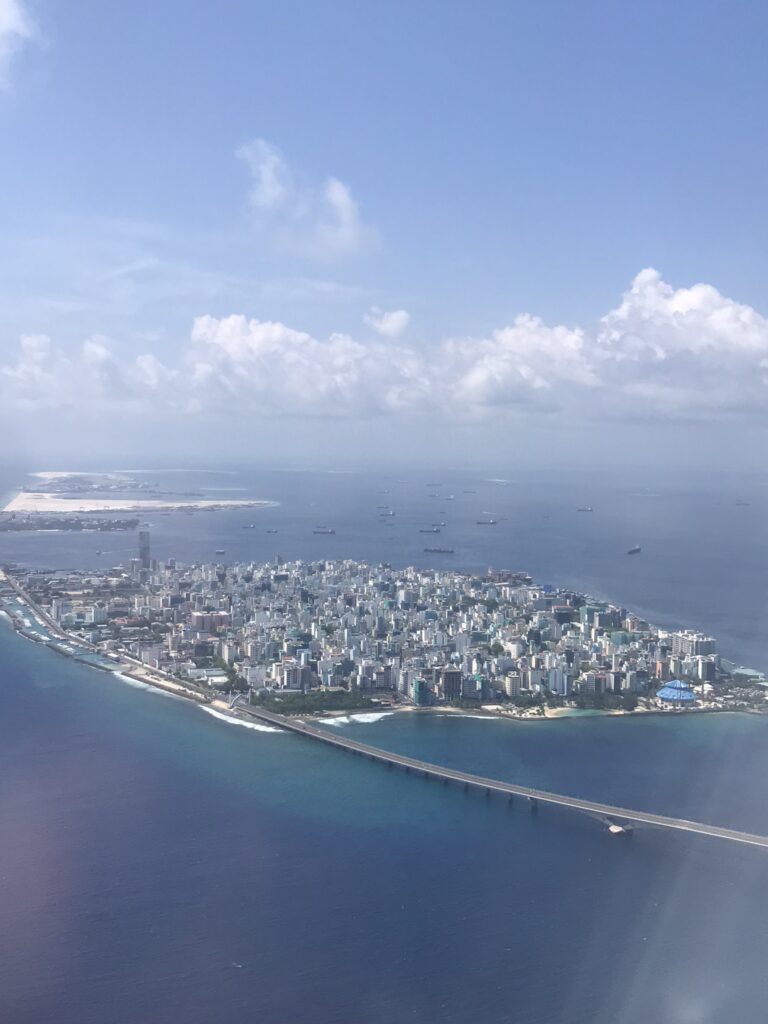
The beating heart of the Maldives, Malé, is a bustling, hectic modern city studded with shiny apartment blocks, tempting restaurants and cafes and lively shopping districts. It is one of the most densely populated cities in the world and the streets are especially packed after dark once the temperature is more pleasant. Mopeds are the main annoyance here as everyone and their uncle seems to have one! At a glance there seems to be more mopeds than people. It can sometimes be difficult to cross the street because of the number of mopeds parked up and we often wondered how people were able to find and identify their bike.
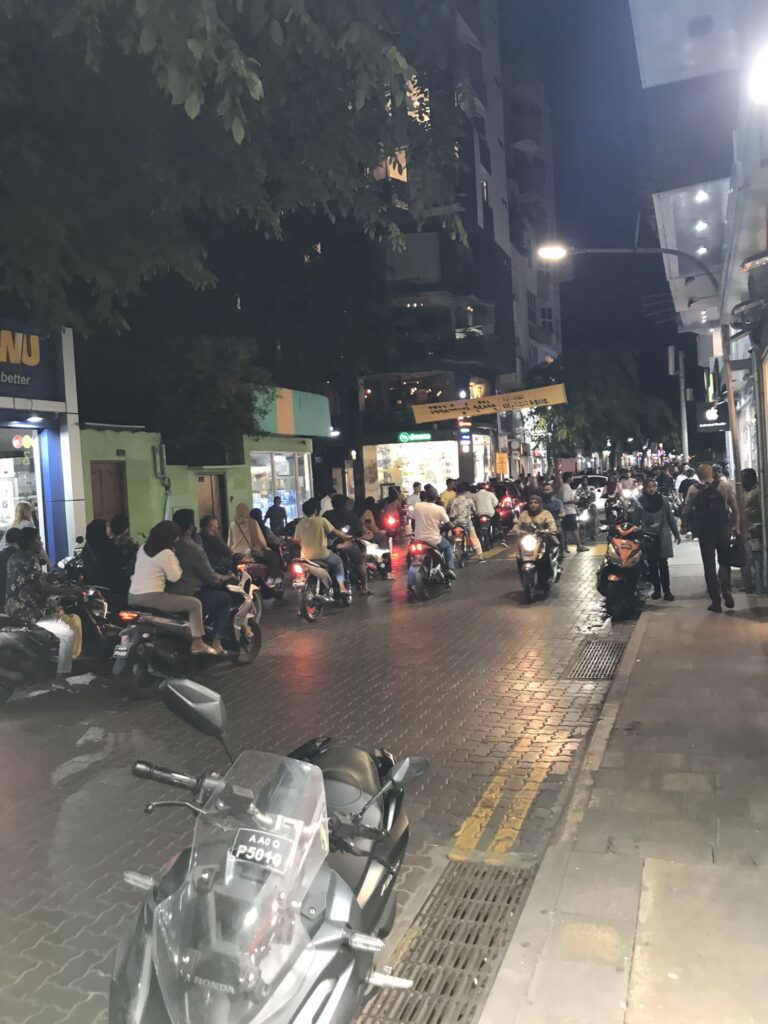
Dodging and weaving mopeds on the streets of Malé
Malé is so compact that it is possible to walk around the entire island in less than an hour. You probably won’t want to, however, due to the high levels of and humidity. Away from the main dock area in the north east and around Republic Square, the island doesn’t feel touristy at all and we saw few if any other travelers outside of these parts. Away from the touts at Republic Square, nobody bothered us and we felt safe enough walking around the island and its many narrow streets.
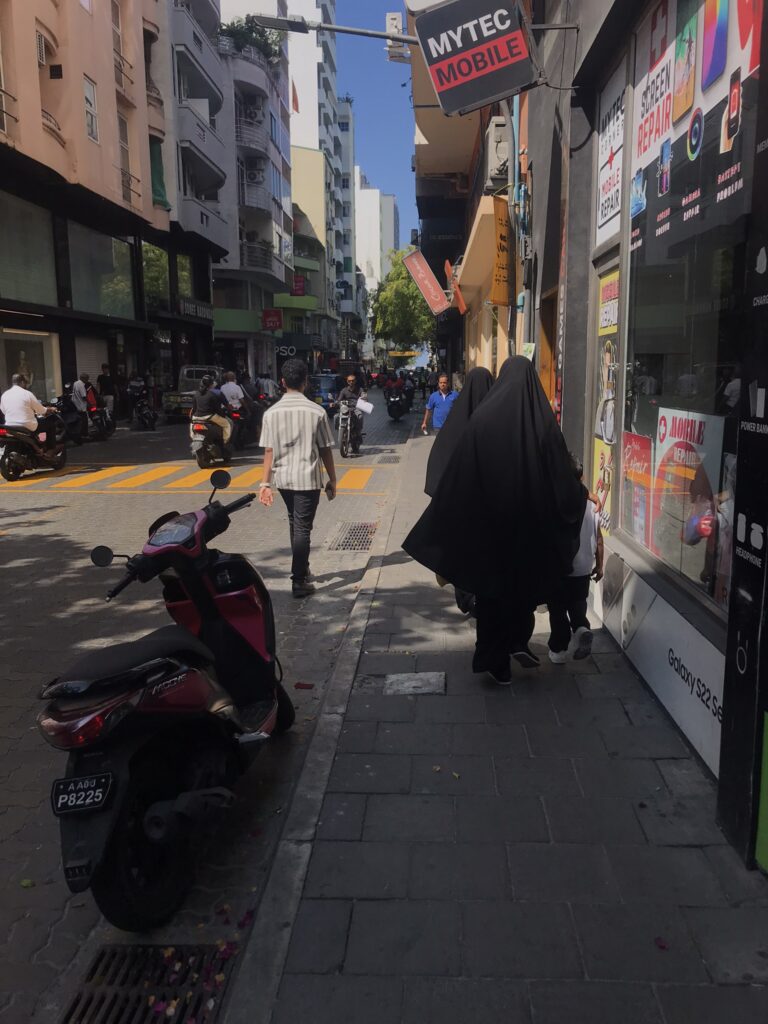
The Maldives is a very religious country and it is common to see women fully covered in Malé
The city of Malé is actually comprised of the main (smaller) island and the island of Hulhule to the north, which contains the airport and another neighbourhood, Hulhumale. Hulhule is linked to the main island by road via the impressive Chinese-built bridge, and also by local ferry which is probably the easiest and cheapest way to get between the two. Around Malé, it is possible to see a number of islands which are dedicated to the logistics and the infrastructure of the city (food import/storage, fuel storage, waste disposal etc).
Malé is also referred to as the ‘King’s Island’ as it is the historical seat of the ruling dynasty. There are a few small attractions in the city and it is worth visiting for a day or so if you are interested in the history and culture of the country. However, to experience the beauty of the Maldives you will need to leave Malé. The main terminal for boats to the local islands is in the north-east around here, and there is also a terminal on the south west side of the island here. We walked to the southwest terminal a day before we were due to head to Gulhi, and were told that the boat we needed was actually leaving from the northeast. If you are unsure, it is probably best to just go there and ask.
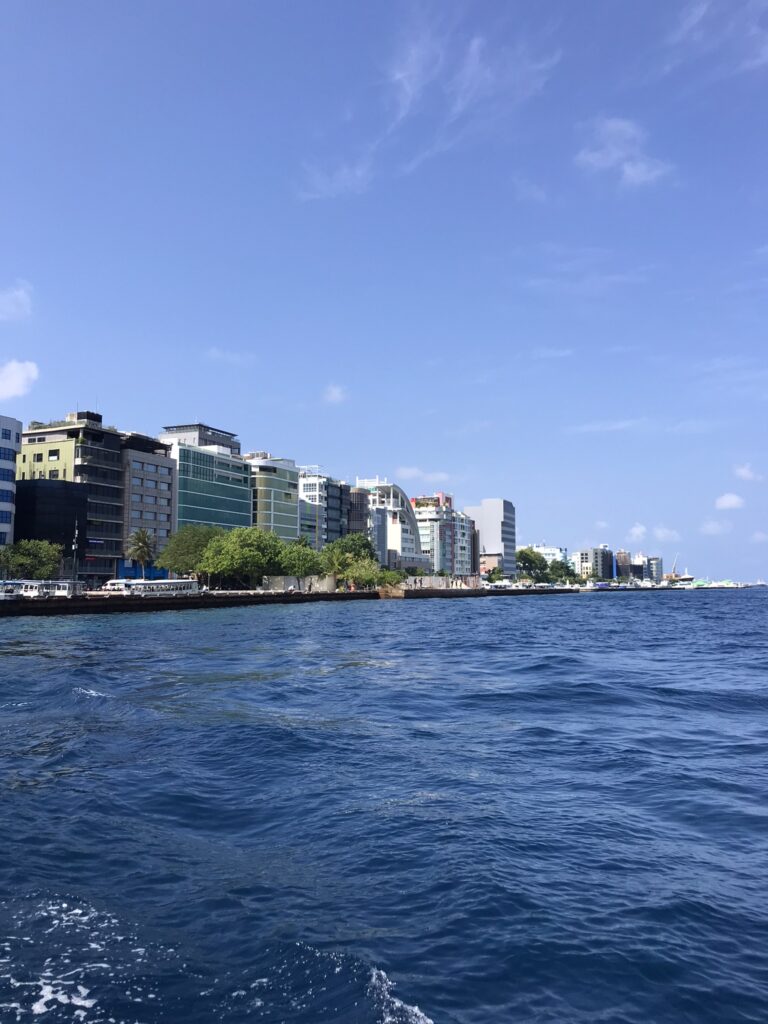
Local ferries along the northern shore in Malé
Attractions
National Museum – the best and most informative (and only?) museum in the country. Inside is an impressive collection of royal paraphernalia like palanquins, thrones and hats which tell the story of the Maldivian royal house. Another area is focused on ethnographical items like traditional clothing, musical instruments and miniature copies of the Quran. There is also information about the archipelago’s nature and modern history. Overall a good place to find out more about the history and culture of the country. We struggled to find the entrance to the museum – it seemed closed from all angles but we eventually were able to access by walking through the car park and around the building. The museum was very quiet, we only saw a handful of other visitors in our time there. Admission fee is a little expensive but is worth it in my opinion as this is the only place you can really find in-depth info about the islands’ culture and history.

Displays at the National Museum in Malé
Sultan Park – If you’re in need of some greenery amid the urban landscape, Sultan park is a nice place to escape from all the mopeds. A great place for a romantic stroll at dusk, however watch out for the fruit bats – they’re as big as crows and like to hang out in the trees in the park, occasionally swooping from one tree to another. These gardens used to be part of the Royal Palace but are now open to the public. We were lucky enough to spot a Maldivian wedding being held in the park.
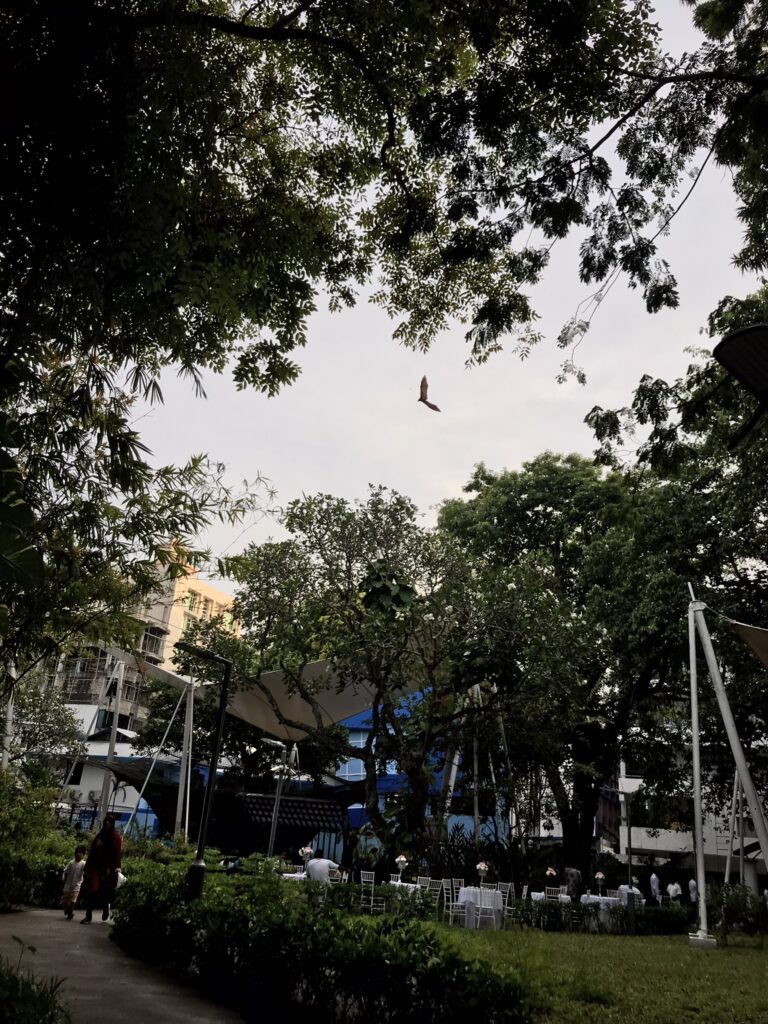
Look out for bats in the park!
Medhu Ziyaaraiy and Hukuru Miskiiy (Old Friday Mosque) – this mausoleum complex contains the shrine and tomb of Abdul Barakat Yoosuf Al Barbary, the man who is said to have first brought Islam to Maldives in 1153. This area also contains the Old Friday Mosque built in 1656, with intricately carved coral rock. You can’t enter the mosque without prior permission from the Ministry of Islamic Affairs (you’ll be stopped by a vigilant guard/groundskeeper) but it is possible to snoop around the outside of the mosque and cemetery. This is as close as it gets to a historical/archaeological site in Malé.

The Old Friday Mosque is the far right building with a corrugated metal roof
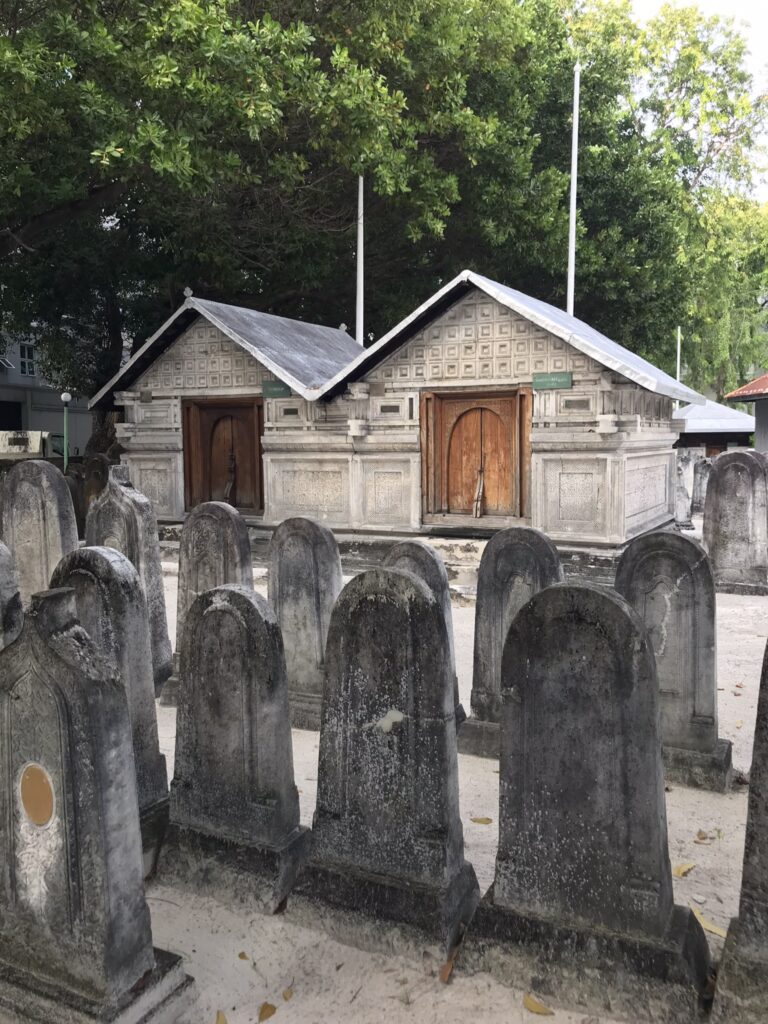
The graveyard is well worth a peek too!
We opted for a GPSmycity walking tour to cover all the main landmarks – here’s the link.
China-Maldives Friendship Bridge (SinaMalé Bridge) – inaugurated in 2018, this Chinese-funded megabridge connects the airport on Hulhule with Malé and the island of Hulhumalé to the north. The bridge is a new convenience for tourists and locals alike making travel back and forth much easier.

As far as bridges go, this one is pretty impressive
Artificial Beach – if the heat and humidity get too much for you, head to the artificial beach for a dip in the Indian Ocean. This is not a bikini beach so make sure you’re fully covered if you want to take a dip in the sea here!
King Salman Mosque – this is the newest mosque to grace the shores of Malé. It’s by no means an orthodox-looking mosque, instead it appears to be constructed from corrugated metal and stone with very sharp-looking towers that pierce the sky in a fusion of the old and new. It’s architecturally very interesting and well worth a visit.

I couldn’t stop thinking that the King Salman Mosque reminded me of a blue crab with pincers
Presidential Palace – Muliaage (Palace) – originally built for the Sultan, this building now serves as the president’s official residence. The palace is closely guarded and visitors are not permitted to enter but you can look from the outside.
Victory Monument – built as a memorial for those who died in the Tamil Tigers terrorist attack in 1988. A poignant reminder of past strife on the island.
Masjid Al-Sultan Muhammad Thakurufaanu Al-Auzam – an important community mosque close to Sultan Park and the Victory monument which is now the Center for Islamic Affairs. Prior to the construction of the King Salman mosque, this was the largest mosque in the country.
Tsunami Monument – a place of quiet reflection near to the southeast ferry terminal commemorating the loss of lives during the 2004 tsunami.
Foodie Places
Woods Cafe MV – a newly opened cafe catering to tourists and locals alike. We were fans of their tasty hummus. It has an extensive menu and prices are very reasonable as it’s located on a side street away from the hustle and bustle of the main thoroughfare.

Woods Café MV has varied menu featuring fried fish and hummus
Seagull Café – a popular stop for tourists serving breakfast, lunch and dinner. They’re also well-known for their ice cream and sundaes. It’s slightly more expensive than the other two options I’ve listed. Dan particularly enjoyed the Maldivian breakfast, which is available all day.

Eat local – try the Maldivian breakfast at Seagulls!
Bianco Coffee & Eatery – ultra-modern white interior with tasty snacks, sandwiches, pastries and light meals. We particularly enjoyed the decadent croque madame and light and creamy lemon pasta. An added bonus is that they have a card machine.
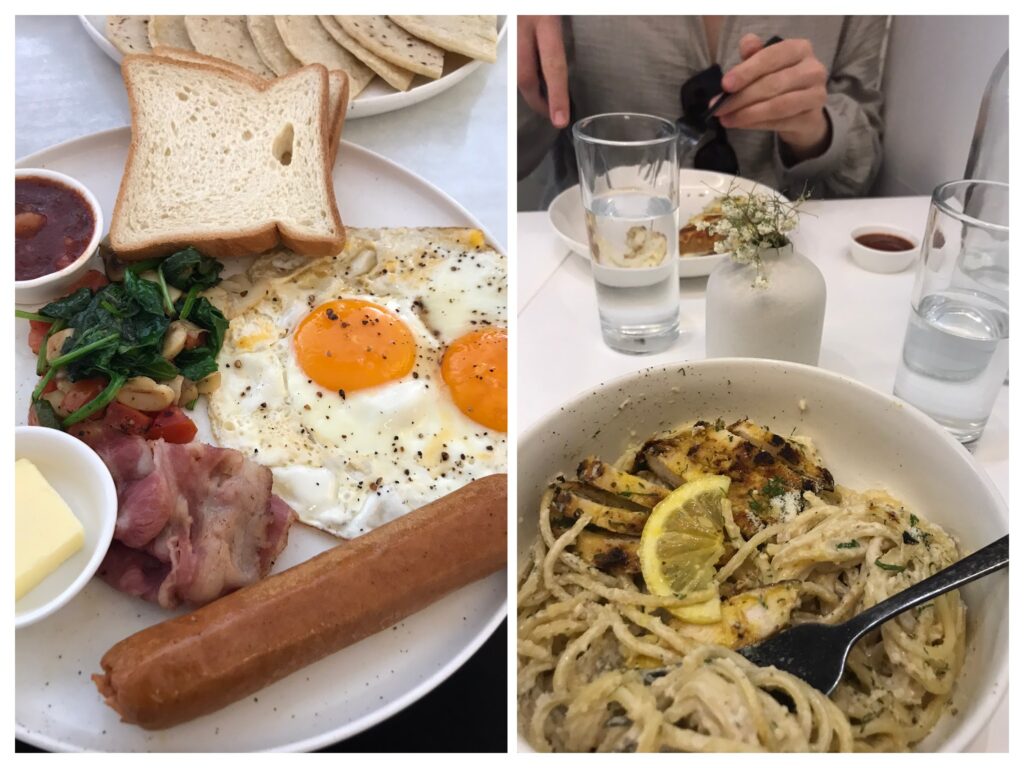
Bianco quickly became one of our favourite places to eat in Malé
Accomodation
Airbnb – there is a large proliferation of budget-friendly Airbnb options in Malé. We stayed in two different Airbnbs and both were comfortable and pleasant. If possible I recommend staying in the vicinity of Sultan Park, as this is a central location with close proximity to the ferry terminal and other sites.
Nalahiya Residence – one of the rooms we booked via Airbnb was in this apartment block, which was very modern and comfortable.
Gulhi
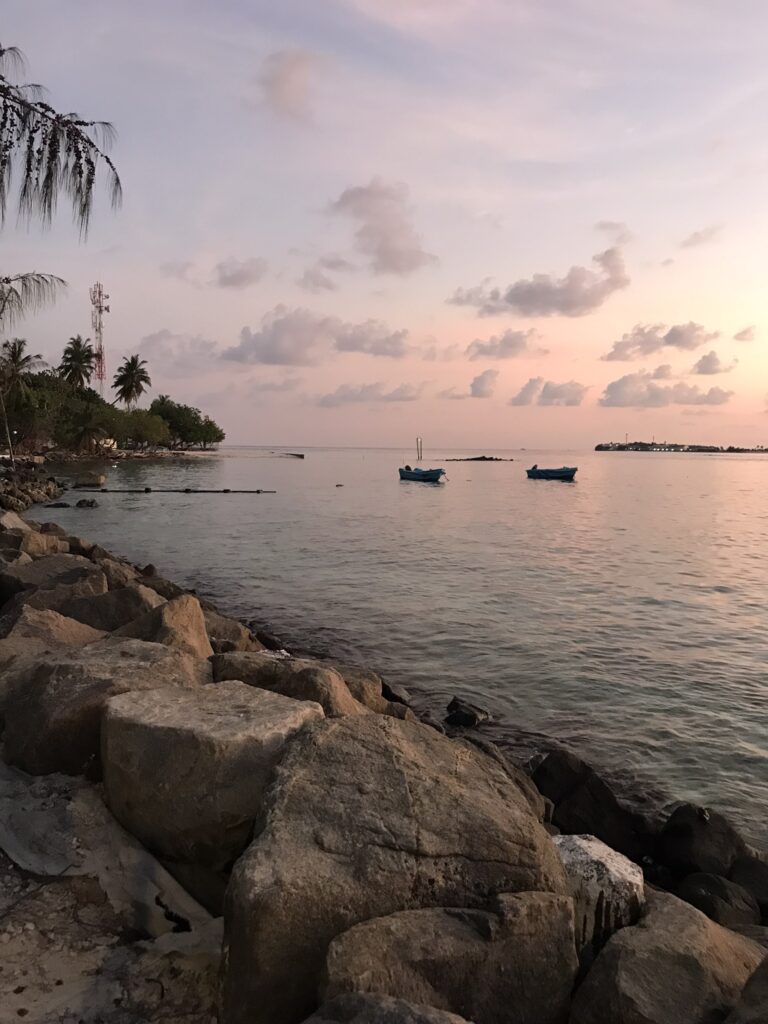
If you’re looking for a small-town vibe but don’t want to spend hours on a ferry to get to the far reaches of the Maldives, Gulhi is a good shout, especially for those trying to get away from the crowds, eye-sore apartment blocks and moped-madness of Malé. It takes just over an hour on the public ferry to get from Malé to Gulhi. You can circumnavigate around the whole island on foot in under 30 minutes. It’s very quaint, compact and family-friendly.
It’s a shame to say that rubbish causes an issue on some local islands, with some visitors reporting it piling up. Gulhi doesn’t have this problem as of yet – the beaches are pristine, sublime white sand and the shallow waters are so transparent they’re like glass. Gulhi’s bikini beach will satisfy your Maldivian dream of calm blue waters, clear sapphire skies and ivory sands without breaking the bank.
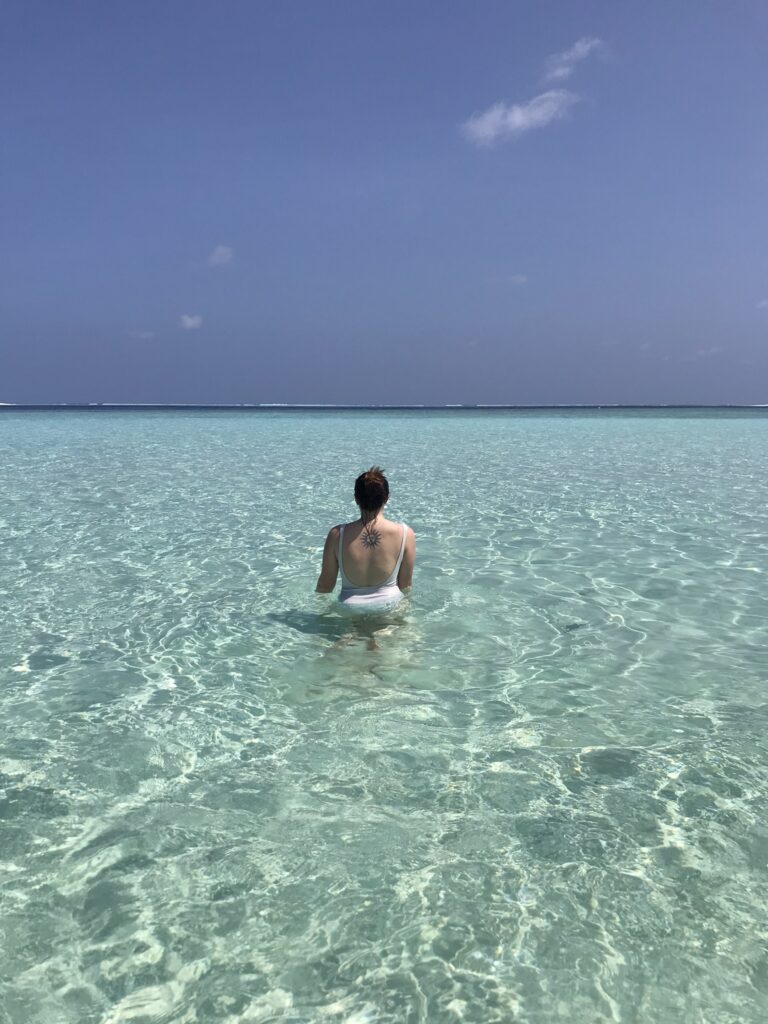
The sea was so shallow and warm that it felt like being in the bath!
Outside of the bikini beach, there is another lesser-visited beach to the south of the island, and a number of tour operators offering diving, snorkeling and boat trips (which we didn’t do). It is also interesting to walk around the quiet back streets and local houses for a while, and you can explore the whole island on foot relatively easily in under an hour. But really, the main attraction here is the beach.
Activities
Eat, chill, read and watch the sunset (facing the west from the harbour). The beach can get quite busy and space in the shade is limited. It is possible to hire a sunbed or a parasol on the beach, which is a good option if you want to spend your time crammed into a corner with a load of other people underneath the only tree.
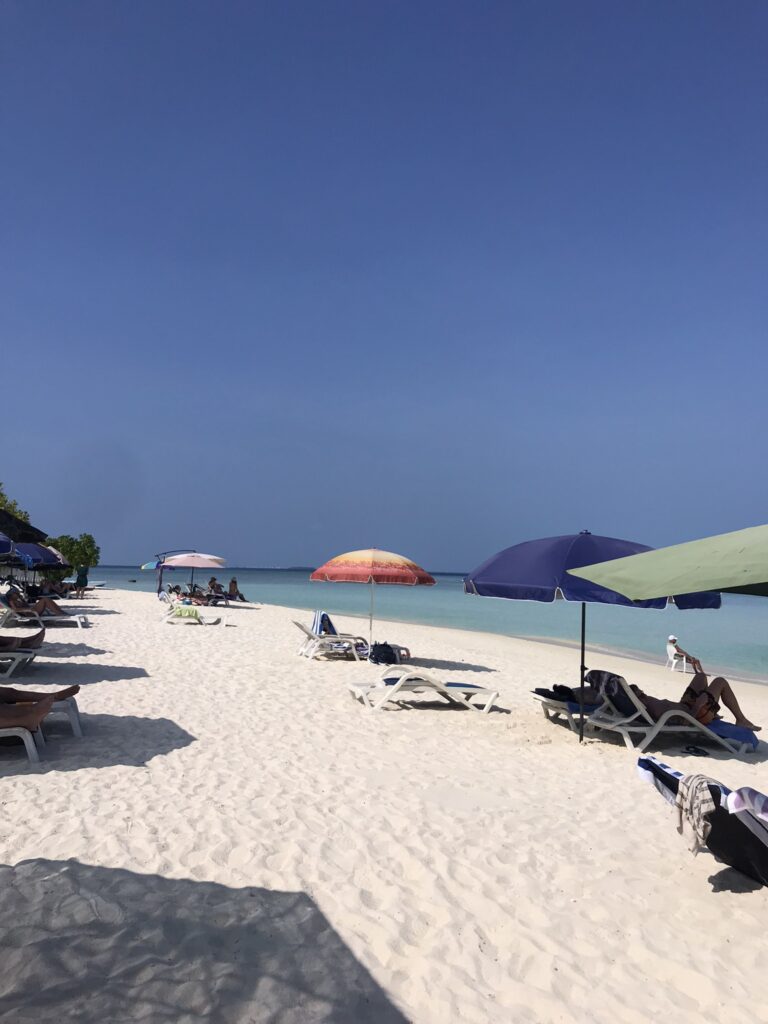
The bikini beach is the only place on Gulhi where you can wear western swimming clothes
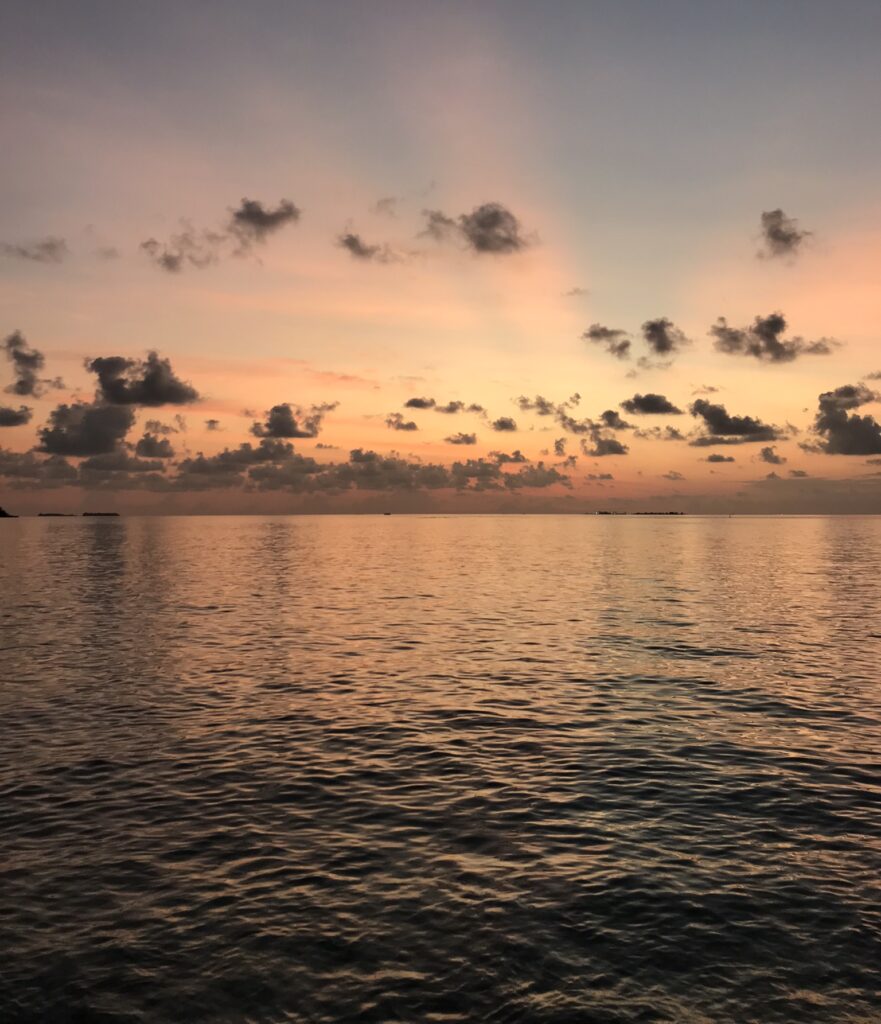
Sunsets are absolutely stunning in the Maldives
At dusk, you can often see sharks in the harbour at this location which is also a good place to watch the sunset
Sometimes there are performances in the area surrounding the harbour – we were lucky enough to see a local band complete with drummers and a singer.
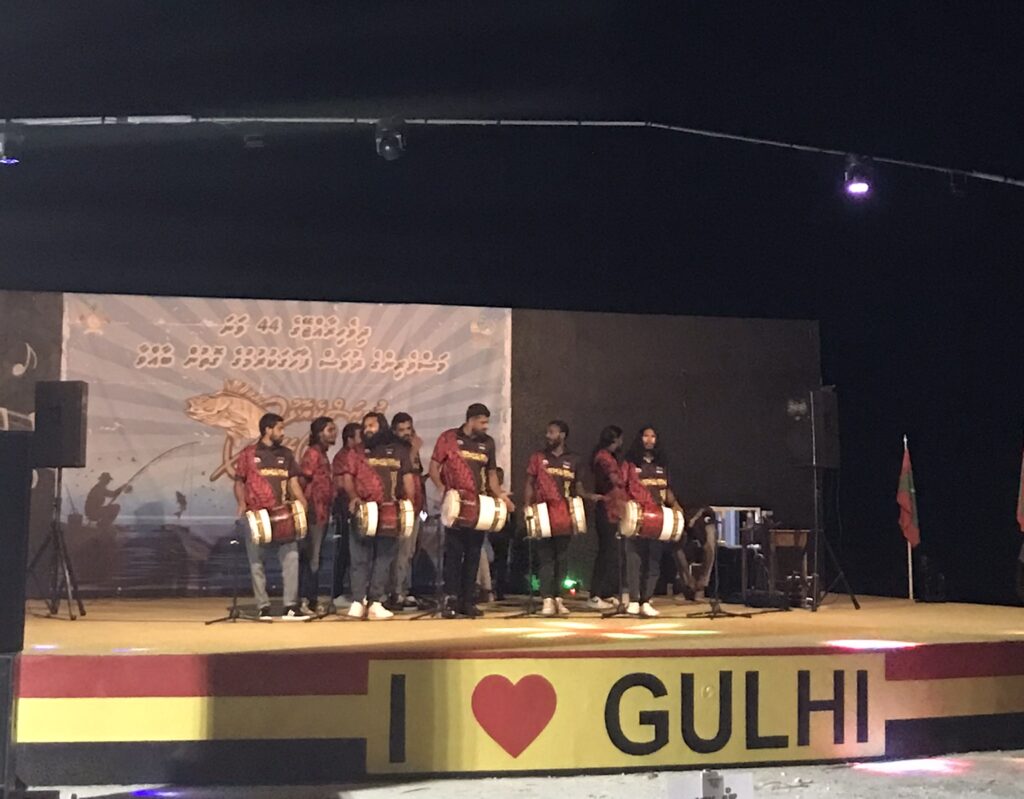
A local band performing in the harbour
Foodie Places
Benha Restaurant – our go-to restaurant on Gulhi – a mixture of western and Maldivian food options situated right across from the harbour and very close to bikini beach. They have seating outside on the sand which makes for a romantic and atmospheric dinner setting.
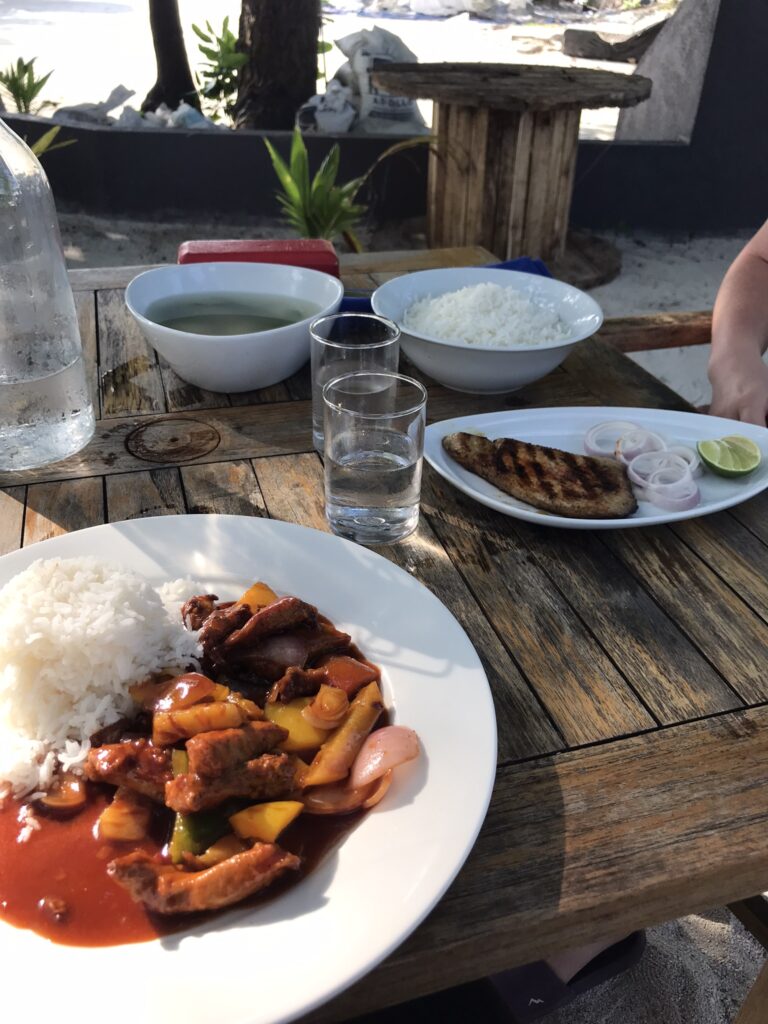
Tasty fish-based cuisine at Benha, Gulhi
Accommodation
Ocean Pearl Maldives – a relatively small guesthouse with only about 4 or 5 rooms located close to the harbour and Bikini beach. Downstairs is a diving company so it would be fairly easy to book snorkelling and diving trips. Clean and comfortable pretty much sums this place up. No kitchen facilities but rooms are kitted out with a mini-fridge.
